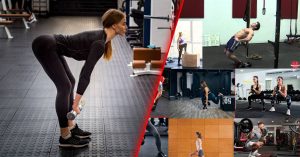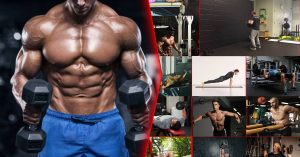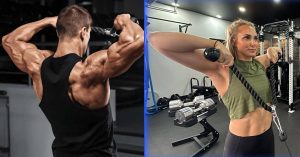Weightlifting platforms, often the overlooked heroes of the gym, are more than just a piece of equipment. They form the very foundation of a serious lifter’s sanctuary. These platforms aren’t merely for aesthetic appeal. They serve a vital purpose in any serious lifting regimen.
By using these Weightlifting platforms, you can easily protect your floor and lifting equipment. Plus, some of the latest models come with a built-in facility to reduce noise and vibration. Hence, you can work out freely without feeling ashamed about making extra noises when dropping huge weights on the ground.
However, the question looms large in the minds of home gym enthusiasts: Do you really need one? To answer this, let’s dive into our detailed article that explores weightlifting platforms, their significance, and whether they should be a staple in your home gym setup or not.
Table of Contents
MORE keyboard_double_arrow_down LESS keyboard_double_arrow_up
Picture your home gym: barbells, weights, a squat rack, and then there’s the often neglected but crucial weightlifting platform. It’s always good to have a such weightlifting platform under These platforms are more than just a surface to stand on. They are engineered for safety and efficacy in weightlifting.
But what exactly constitutes a weightlifting platform, and what varieties are there in the market? Our journey starts here, unraveling the essence of these platforms.
What is a Weightlifting Platform?
At its core, a weightlifting platform is a resilient, robust surface tailored for intense weightlifting activities. It is used as an intermediate platform between your heavy weights and the floor of the gym or your home gym. Normally they are placed beneath a Squat rack or Power rack.
These platforms are usually constructed from a fusion of materials like plywood and rubber in general. Thus it offers a unique combination of firmness and shock absorption. This dual-function design doesn’t just safeguard your floors but also preserves the integrity of your weights.
There are two types of weightlifting platforms that are used in general.
- Deadlift platform
- Olympic lifting platform
Let us find out further about these platforms in the next sections.
1. Deadlift platform
The deadlift platform typically features a smaller and sleeker design compared to Olympic lifting platforms.
Measuring around 8 feet in width to comfortably hold the barbell, they are only 4 feet in length.

Rogue Deadlift Platform
The center of the platform is constructed from wood to ensure a sturdy surface for lifting. Plus, the outer sections on both sides are layered with rubber to absorb impact and protect the floor and weights.
Rubber platforms are the most durable and provide the best noise reduction, but they are also the most expensive. Wood platforms are less expensive, but they are not as durable and may not provide as much noise reduction.
Given that deadlifts involve lowering the weight from waist height, rather than dropping it from a greater distance, the platform doesn’t require excessive thickness or cushioning. Hence the thickness of the platform usually measures around 4 inches thick.
Here are some additional things to consider when choosing a deadlift platform:
- Thickness: The thickness of the platform will affect how much shock it absorbs. A thicker platform will be more comfortable to lift on and will provide better protection for your floor.
- Weight capacity: Make sure the platform you choose is rated for the weight you will be lifting.
- Portability: If you need to be able to move your platform around, choose one that is lightweight and easy to assemble.
- Price: Deadlift platforms range in price from around $100 to $500 or more.
2. Olympic lifting platform (OLP)
Olympic lifting platforms are made with raised platforms specifically designed to do Olympic weightlifting exercises. They are typically constructed with larger dimensions. You can often see these platforms in gym areas measuring 8 feet by 8 feet and are often engineered to be thicker, ranging from 8 to 12 inches.

American Barbell Weightlifting Platform
These platforms are specifically designed for executing intricate Olympic lifts, such as snatch, clean and jerk, and squats.
During the execution of these complex lifts, it is customary to release the barbell from an overhead position.
The impact force exerted when the weight makes contact with the ground is substantial.
As a result, the platforms are manufactured with increased thickness to safeguard both the flooring and the weight plates loaded onto the barbell.
Materials commonly used for OLPs include:
- Rubber: The most popular choice, offering excellent durability, impact absorption, and noise reduction. Rubber platforms come in various thicknesses and densities to suit different needs and budgets.
- Wood: A more affordable option, but less durable than rubber and may not provide the same level of shock absorption. Plywood and maple are common wood choices for OLPs.
- Combination: Some platforms combine a rubber base with a wood top layer, offering a balance of affordability, stability, and shock absorption.
Here are some additional factors to consider when choosing an Olympic lifting platform:
- Weight capacity: Ensure the platform can handle the maximum weight you intend to lift.
- Portability: Consider how often you need to move the platform and choose one with portability features if needed.
- Budget: Olympic lifting platforms range in price depending on size, material, and features. Expect to spend anywhere from $200 to $1000 or more.
Why is it better to have a Weightlifting Platform in your home gym?
It is not mandatory to have a Weightlifting Platform in your home gym. But if you could manage to install a lifting platform within your gym area, then there are a considerable amount of benefits that can enhance your training experience and protect your space.
Here’s why it might be a good investment:
1. Floor and Equipment Protection
One of the primary functions of a weightlifting platform is to protect your flooring from damage. Dropping heavy weights can cause significant harm to both your floors and your lifting equipment. These platforms act as a protective layer, absorbing the shock and impact that comes with heavy lifting, thereby extending the life of your gym flooring and equipment.
In summary:
- Floor: The primary benefit is protecting your floor from damage caused by dropped weights, especially if you’re lifting heavy or practicing Olympic lifts that involve dropping the bar. This is crucial for delicate surfaces like wood, tile, or even concrete that can crack under repeated impact.
- Equipment: The platform also absorbs the shock of dropped weights, protecting your barbell and plates from wear and tear. Yes, most of the weights that you are buying for deadlifts and Olympic lifts are made up of steel and engraved in a protective rubber layer. That is more than enough to protect them. Yet, they will last longer if you can lift and drop them on a lifting platform.
2. Enhancing Your Lifting Experience and Performance
Beyond protection, weightlifting platforms contribute significantly to the quality of your workouts. They provide a stable, even surface essential for maintaining proper form and balance during lifts. This stability is particularly important for complex and technical lifts often found in Olympic lifting and powerlifting routines.
In Summary:
- Stability: The platform provides a sturdy and stable base that can improve your lifting form and technique. This is especially important for compound exercises like squats, deadlifts, and Olympic lifts, where proper form is crucial for safety and optimal performance.
- Sound reduction: The platform dampens the noise of dropped weights, creating a quieter training environment. It will be really helpful if you share your space with others or live in an apartment.
3. Safety First
Another critical aspect of weightlifting platforms is the safety they offer. Equipped with a non-slip surface, these platforms ensure a secure footing, allowing you to focus on your lifts without the worry of slipping, especially when handling heavier weights.
Some platforms have a textured surface that can enhance your grip on the floor, particularly beneficial for heavy lifts and explosive movements like cleans and jerks. This safety feature is indispensable, particularly in home gym setups where professional supervision might be lacking.
4. You can Comfortably Practice Competitive Lifting
It doesn’t matter whether you’re into CrossFit, Strongman, or Olympic lifting. For competitive lifting, it’s crucial to replicate the competition setup in training,
This involves using the appropriate equipment, including
- Barbells,
- Weight discs,
- Racks,
- Platforms.
You can train on Weightlifting platforms thinking you are in a competition stage. Plus it will ensure every lift counts. Additionally, they create an ideal training environment with a stable, slip-resistant surface, enabling focused lifting without concerns about footing.
Such preparation on a platform will facilitate your readiness for current and future competitions.
5. You can be yourself and feel like a pro
Having a weightlifting platform in your home gym offers numerous benefits. Notably, it allows you to feel like a badass as you train, providing a dedicated space to exert yourself with grunts, strains, and heaves like elite athletes.
Moreover, the lifting platform ensures the protection of both your weights and floors, enabling you to train with full intensity without worrying about damaging your equipment or surroundings. Overall, installing a weightlifting platform in your home is a practical investment that enhances your workout experience and helps you achieve your fitness goals.
6. Additional benefits:
- Dedicated lifting zone: The platform can create a dedicated area for your weightlifting activities, helping you stay focused and motivated during your workouts.
- Improved comfort: Some platforms are designed with shock-absorbing materials that can make heavy lifting more comfortable on your joints.
Can a weightlifting platform be used for all types of weightlifting?
Yes, While weightlifting platforms are primarily designed for Olympic-style weightlifting, such as snatches and cleans, they can also be used for other types of weightlifting exercises. These platforms provide a stable and shock-absorbent surface that is beneficial for heavy lifts and reduces the risk of damage to both the equipment and the floor.
However, for exercises like powerlifting, where the barbell is typically lowered to the ground with less force, a weightlifting platform may not be necessary but can still offer advantages in terms of stability and protection.
Ultimately, the suitability of a weightlifting platform for different types of weightlifting depends on individual preferences and specific training needs.
Is there are any alternatives to use for a home gym instead of using branded Weightlifting Platforms?
Yes, there are alternatives that you can use instead of weightlifting platforms. We all know that most of us don’t have a large dedicated space to fill a lifting platform that has a scale of 8×8’ or even a 4×8’ one. Don’t worry. In this section, we will show you some alternatives that you can use instead of these branded lifting platforms.
Some of these alternatives can be installed in a limited space like:
- In your small basement,
- Even in a garage with small extra space,
- In a gym room where you’ve got a lot of other gym equipment or stored items taking up the room.
Here are some alternatives:
1. Gym Mats:
Gym mats, typically made of rubber or synthetic materials, are designed for gym use. they provide excellent grip, impact absorption, and cushioning. They can be utilized to establish a compact deadlifting area, with the option to stack several mats underneath for enhanced impact absorption.
However, these mats are heavy and unwieldy, making them challenging to move around. Therefore, it’s advisable to set up your lifting station and keep the mats in place for the duration of your training session.
- Pros: Highly durable and thick, excellent shock absorption, affordable, good traction.
- Cons: Bulky and heavy, may require trimming to fit your space, can have a strong rubber odor initially
2. Deadlift pads:
Deadlift pads are also known as crash pads or silencer pads. They are thick foam pads covered in durable nylon fabric. These pads are placed directly beneath the area where you drop weights. They provide some protection to the floor.
It is not the most durable option due to foam compression and potential nylon damage over time. However, they offer portability and affordability compared to weightlifting platforms. You just have to simply place the deadlift pads underneath the weight’s landing position when lifting heavy weights, so that you can lift and drop the weight safely onto the pad.
Deadlift pads offer floor and weight protection, yet they do not provide the raised, stable surface for training that a lifting platform does. Nonetheless, they are a viable choice for individuals facing limited training space.
3. Horse stall mats:
Horse stall mats have served as a popular alternative to gym mats for many years. These mats are made up of similar materials that are used to create Gym mats. They offer comparable functionality, providing effective cushioning for weights during workouts.
Additionally, they are more readily available in rural areas and may come at a lower cost compared to traditional gym mats.
4. Rubber mats
Rubber mats present a convenient flooring solution for home gyms, offering various advantages. They are affordable, widely accessible, and provide effective protection against floor damage and noise reduction during workouts.
Additionally, rubber mats are easy to store and clean, enhancing their practicality.
However, they may not offer the same level of stability as lifting platforms and might lack adequate shock absorption for heavier lifts, which could be considered a drawback for some users.
5. Plywood sheets
Plywood sheets offer a cost-effective option for creating a workout surface in home gyms, with several advantages. They are budget-friendly and can be easily tailored to fit specific size and layout requirements.
Additionally, plywood sheets can be combined with rubber mats to enhance cushioning during workouts.
However, they may not match the durability of rubber or stall mats and require sealing to safeguard against moisture and wear over time.
Moreover, for individuals engaging in heavy Olympic lifts, plywood sheets may not provide sufficient shock absorption, which could be considered a drawback.
6. Foam tiles
Foam tiles offer a convenient flooring solution for home gyms, with several advantages. They are lightweight and simple to assemble and disassemble, providing flexibility in setup.
Additionally, foam tiles offer comfort for joints, making them ideal for bodyweight exercises and light weightlifting routines.
However, they may not be suitable for heavy weightlifting due to their limited durability and shock absorption capabilities.
Furthermore, the cost of foam tiles can vary depending on thickness and quality, potentially making them a more expensive option.
7. DIY lifting platform
For those seeking a professional setup in their home gym despite limited space, consider crafting a DIY lifting platform. This involves constructing a platform typically 8 feet long but only 2 or 3 feet wide, depending on available space, using plywood or OSB wood and rubber mats secured with glue.
The customizable size allows adaptation to fit around existing gym equipment, offering a tailored solution for home workout spaces.
- Pros: Highly customizable, can be tailored to your exact needs and budget, and sense of accomplishment from building your own equipment.
- Cons: Requires time, effort, and DIY skills, may not be as sturdy or stable as pre-made platforms, safety considerations during construction.
How do DIY platforms compare to pre-made ones?
DIY platforms and pre-made ones both offer benefits and drawbacks. DIY platforms are often more cost-effective and customizable, allowing you to tailor the size and materials to fit your space and preferences.
However, they may require more time and effort to construct, and the quality of the materials and construction can vary depending on your DIY skills.
On the other hand, pre-made platforms are typically professionally constructed with high-quality materials, offering durability and reliability out of the box.
While they may be more expensive upfront, pre-made platforms often require minimal assembly and can provide a more polished and consistent training experience.
Ultimately, the choice between DIY and pre-made platforms depends on factors such as budget, skill level, and personal preferences.
Do You Really Need a Weightlifting Platform?
The decision to invest in a weightlifting platform should be based on several personal and practical considerations:
- Your Lifting Style: The nature of your workouts plays a crucial role. For heavy and technical lifting, a platform is highly recommended.
- Space Considerations: The availability of space in your gym area is a key factor. Weightlifting platforms require a certain amount of room. So, it’s important to ensure you have the space to accommodate one.
Budgetary Considerations: Budget is a significant factor in this decision. Thankfully, there are options available for every budget, from cost-effective DIY platforms to more expensive, high-end models.
Making an Informed Choice
When it comes to choosing the right weightlifting platform, it’s essential to consider various factors to ensure you make an informed decision that suits your specific needs.
Here are some crucial tips to keep in mind:
- Size and Weight Capacity: It’s important to select a platform that fits your space and can handle the weight you plan to lift. An inadequately sized or weak platform can lead to inefficiency and safety risks.
- Look for Non-Slip Surfaces: Safety should always be a priority. Choose platforms with a good grip to prevent any accidents during your workouts.
- Focus on Quality for DIY Platforms: If you decide to build your own platform, don’t compromise on the quality of materials. Stability and durability are key for a safe lifting environment.
- Maintain Regularly: Like any piece of gym equipment, your weightlifting platform needs regular maintenance. This ensures its longevity and keeps it safe for continuous use.
To Platform or Not to Platform: Final Verdict
Weightlifting platforms have become a cornerstone in the arsenal of gym equipment, especially for those who take their lifting seriously. These platforms are not just about adding a professional touch to your gym; they are about fundamentally enhancing your training experience.
Weightlifting platforms can significantly enhance your training experience, offering safety, equipment longevity, and a professional feel to your workouts. We invite you to evaluate your lifting needs and make an informed decision to possibly elevate your training to new heights.
Key points
- Weightlifting platforms serve as crucial components in a serious lifter’s gym setup, protecting both the floor and equipment during heavy lifts.
- They are commonly constructed from materials like rubber, wood, and steel, ensuring durability and stability during intense workouts.
- They are suitable for various weightlifting exercises, including deadlifts, squats, and Olympic lifts, making them versatile additions to any gym space.
- There are two types of Weightlifting Platforms: Two main types include deadlift platforms, designed for heavier lifts with specific dimensions and materials, and Olympic lifting platforms, engineered for technical Olympic lifts like snatches and cleans.
- Features of Deadlift Platforms: Typically smaller in size, around 8×4 feet, constructed with a wooden center for stability and rubber sides for impact absorption and floor protection.
- Considerations When Choosing a Deadlift Platform: Thickness, weight capacity, portability, and budget are essential factors to evaluate before making a purchase.
- Features of Olympic Lifting Platforms: Larger in size, usually 8×8 feet, with increased thickness (8 to 12 inches) to withstand the force of dropping heavy weights during Olympic lifts.
- Material Options for Olympic Lifting Platforms: Rubber offers excellent durability and noise reduction, while wood provides a more affordable alternative with less shock absorption.
- Benefits of Weightlifting Platforms: Beyond floor and equipment protection, platforms contribute to improved lifting performance, stability, safety, and a dedicated training space.
- Considerations for DIY vs. Pre-made Platforms: While DIY platforms offer customization and cost-effectiveness, pre-made platforms provide professional construction and reliability, each with its own set of advantages and drawbacks
FAQs
What does a weightlifting platform do?
The main goal of using a weightlifting platform is to protect the gym floor and weightlifting equipment. When a barbell loaded with weights is dropped, a lifting platform can assist in absorbing a portion of the shock, thereby minimizing the impact on the floor and decreasing the likelihood of damage.
How big is a weightlifting platform?
The conventional lifting platform measures 8×8 feet, offering convenience due to its alignment with standard sheets of plywood, which are also 4×8 feet. This size provides sufficient space for all weightlifting activities required during training, including the accommodation of a squat rack positioned at one end of the platform.
What is the best material for a weightlifting platform?
A weightlifting platform ought to be crafted from top-notch, resilient materials capable of enduring rigorous usage and bearing substantial loads. These materials commonly include rubber, wood, and steel.

ABOUT THE AUTHOR
Follow Valen Steven for a dose of fitness enthusiasm, evidence-based advice, and a roadmap to achieving your health and wellness goals.
Subscribe to our Newsletter
Dive into a world of fitness and wellness with our exclusive newsletter! Sign up now and receive weekly power-packs of fitness wisdom




